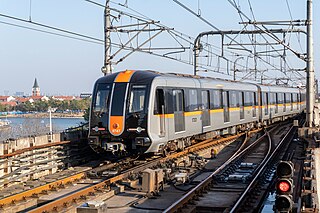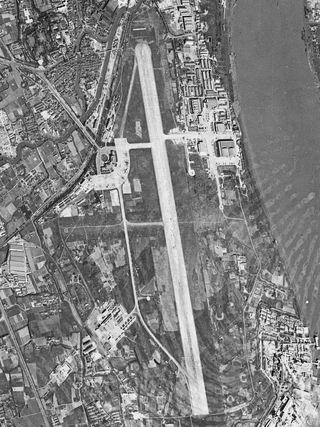
Transportation in South Korea is provided by extensive networks of railways, highways, bus routes, ferry services and air routes that traverse the country. South Korea is the third country in the world to operate a maglev train, which is an automatically run people mover at Incheon International Airport.

Pudong is a district of Shanghai located east of the Huangpu, the river which flows through central Shanghai. The name Pudong was originally applied to the Huangpu's east bank, directly across from the west bank or Puxi, the historic city center. It now refers to the broader Pudong New Area, a state-level new area which extends all the way to the East China Sea.

The Bund is a waterfront area and a protected historical district in central Shanghai. The area centers on a section of Zhongshan Road within the former Shanghai International Settlement, which runs along the western bank of the Huangpu River in the eastern part of Huangpu. The area along the river faces the modern skyscrapers of Lujiazui in Pudong. The Bund usually refers to the buildings and wharves on this section of the road, as well as some adjacent areas. This region has a significant European influence, with the style of many structures most comparable to that of European cities, particularly Gothic, Baroque, Neoclassical, Romanesque, Art Deco, and Renaissance architecture. Additionally, some of the city's top eateries are located there. From the 1860s to the 1930s, it was the rich and powerful center of the foreign establishment in Shanghai, operating as a legally protected treaty port.

The Shanghai Metro (Chinese: 上海地铁; pinyin: Shànghǎi Dìtiě; Shanghainese: Zaon6he5 Di6thiq7) is a rapid transit system in Shanghai, operating urban and suburban transit services to 14 of its 16 municipal districts and to the neighboring township of Huaqiao, in Kunshan, Jiangsu Province.

A moveable bridge, or movable bridge, is a bridge that moves to allow passage for boats or barges. In American English, the term is synonymous with drawbridge, and the latter is the common term, but drawbridge can be limited to the narrower, historical definition used in some other forms of English, in which drawbridge refers to only a specific type of moveable bridge often found in castles.

MV Queen of Alberni is a C-class ferry that operates between Tsawwassen and Duke Point in British Columbia as part of the BC Ferries fleet.

Line 4 is a loop line of the Shanghai Metro network. The older rolling stock 04A01 carry a bright purple colour belt to differentiate them from Line 3 trains which share a portion of its route, while the newer 04A02 stock features a yellow and purple livery, which the exact line is labelled using sticker or screens saying "Line 3" or "Line 4". To determine the direction of travel, the line that travels counter-clockwise is called the Outer Loop (外环), while the other line is known as the Inner Loop (内环). Although it is a loop line, trains returning to the depot use Yishan Road as a terminal to let all passengers disembark. The first segment of the line between Damuqiao Road and Lancun Road opened on December 31, 2005. The remainder of the line opened on December 29, 2007. The line is colored purple on system maps.

Shanghai has around 2000 formal bus lines, served by more than 10 bus companies. In the past, Bashi, Dazhong, Guanzhong and Qiangsheng were the four largest; around 2009 they merged to become Bashi Group Companies, including Bashi No.1-6 Bus Passenger Service Companies, Bashi Tram, Bashi Xinxin and Chongming Company, Baoshan Company and Jinshan Company. Each Suburban district also renewed with one company serving each district. Around 2015, Bashi No.1 Passenger Service and Bashi Tram merged to be Bashi No.1 Company, Bashi No.2 Passenger Service became Bashi No.2 Company, Bashi No.3, No.4 Passenger Service merged to be Bashi No.3 Company, Bashi No.6 Passenger Service became Bashi No.4 Company, and Bashi No.5 Passenger Service and Baoshan Company became Bashi No.5 Company.

Line 9 is a southwest-northeast line of the Shanghai Metro network. The line runs from Shanghai Songjiang Railway Station in Songjiang District to Caolu in Pudong. The line is colored light blue on system maps.

Line 10 is a southwest–northeast line of the Shanghai Metro network that opened for service on April 10, 2010. The line runs from Jilong Road to Hongqiao Railway Station, with a branch line from Longxi Road to Hangzhong Road. It has been given the unofficial nickname “Golden Line” as it links many of the city's tourist attractions like Yuyuan and Xintiandi. It connects the Hongqiao International Airport with the downtown core of Shanghai, and also the dense residential districts of Yangpu and Hongkou. It is the only line in the system with numbered station codes. It is the first high-density and high-volume fully automatic subway line in mainland China, operating with GoA4 unattended train operation. The line is colored lilac on system maps.

Shanghai Longhua Airport, then called Shanghai Lunghwa Airport, was a converted general aviation airport and PLAAF airfield located south of downtown Shanghai, China, on the bank of the Huangpu River. It opened in the early 1920s and served as the city's airport until the 1950s when Shanghai Hongqiao International Airport opened. Thereafter, it was one of two general aviation airports serving Shanghai and also served as an emergency landing site for police, fire and rescue operations southwest of the city. The airport was eventually closed at 1966, and the airport grounds were slowly built over though a period of between 1993 and 2016.

The 2009 Bangladesh ferry accident occurred on 4 December 2009 on the Daira river located in Mithamain Upazila, Kishoreganj District in Bangladesh. A passenger ferry collided head-on with a launch. At least 47 people were killed. The accident occurred in the morning when the river was covered by fog.

The Villa Soldati level crossing disaster occurred on the morning of June 11, 1962 in the Villa Soldati neighborhood of Buenos Aires, when, in dense fog, a train struck a municipal bus carrying schoolchildren.
On 15 July 2014, at around 8:40 am MSK (UTC+04:00), an outbound Moscow Metro train derailed between Park Pobedy and Slavyansky Bulvar stations of the Arbatsko-Pokrovskaya Line. Casualties reported include 24 dead and 160 injured. Early reports suggested a power surge or a terrorist attack to be the cause of the derailment, but both were soon dismissed.

On 31 December 2014, a deadly crush occurred in Shanghai, near Chen Yi Square on the Bund, where around 300,000 people had gathered for the new year celebration. Thirty-six people were killed and another 49 were injured, and in those 49 injured, 13 were injured seriously.

The Shanghai Ferry is a system of ferry routes across the Huangpu River in Shanghai. The ferry service started on January 5, 1911 by the municipal authorities in Pudong. Before the 1970s, the ferry service was the only way to cross the Huangpu River. In the 1980s, the Shanghai Ferry became one of the busiest ferry services in the world. In the 1990s, as bridges and tunnels across the Huangpu river were built, the ferry service saw a sharp drop in ridership. The Shanghai Ferry currently consists of 18 ferry lines and is operated by the state-owned Shanghai Ferry Company.

Airport Link Line of Shanghai Suburban Railway is a commuter rail line, running from Hongqiao Airport Terminal 2 in Minhang District to Shanghai East railway station in Pudong. The 68.6-kilometer (42.6 mi) express line shortens the travel time between the airports of Hongqiao and Pudong from 90 minutes to under 40 minutes. Construction started in June 2019. The Hongqiao Airport Terminal 2 to Pudong Airport Terminal 1&2 section of the line started operations on 27 December 2024.

The Black Christmas disaster was a series of air crashes that took place in Shanghai, China, on 25 December 1946. This event involved three out of the four flights scheduled for Shanghai that day, including CA 48, CNAC 140, and CNAC 115. These crashes were primarily attributed to extremely poor visibility conditions due to foggy weather. As a result, the air crashes disaster claimed the lives of 74 and resulted in 8 injuries.

















